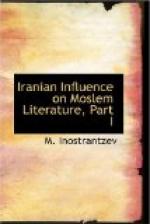[Footnote 1: The Bihafridiya formed a heresy from Zoroastrianism in the time of the Moslems. The sect furnishes the strongest proof that there was no persecution worth the name in Persia at the time. Not only in those days were the Zoroastrians permitted to follow their own faith but here is a curious pars from Al Biruni which proves that both the original Zoroastrians and the heresy were permitted to flourish side by side under the Khalifs:—“When Abu Moslem came to Nishapur the mobeds and herbeds assembled before him telling him that this man [the founder of the Bihafridi sect] had infected Islam as well as their own [Zoroastrian] religion. So he sent Abdalla to fetch him. He met him in the mountain at Badjeh and brought him before Abu Moslem to put him to death together with such of his followers as he could capture. His followers called the Bihafridians still keep the institutes of their founder and strongly resemble the Zam-Zamis among the Magians.” Shaharastani adds that they were the most hostile of God’s creatures to the Zamzami Magians. The entire chapter on the Iranian sects in Shaharastani is worthy of careful and deep study. It explains the divergence between the prescriptions of the Vendidad and the practice of the bulk of the Iranians. The Vendidad was, it would appear, the authoritative scripture of one of the sects of Zoroastrianism. At any rate it is not too extravagant to deduce from the careful studies of the Iranian religion by Arab writers that as the teachings of Sakya Muni developed into more Buddhisms than one so there were several creeds with the common designation of Zoroastrianism.]
[Sidenote: The dignity of Mobedan Mobed.]
The Magians and the followers of the Two Principles and the followers of Mani and the other sects which are related to the Magians are known as the adherents of the Great creed or the Great religion. All the kings of Persia were the followers of the religion of Ibrahim, subjects and all those who belonged to the country among them during the reign of each of them followed the religion of their rulers. But these latter relied upon the chief of the ecclesiastics, Mobed Mobedan, the sage of sages, and the wisest of men according to whose instructions the kings conducted themselves and without whose judgment they undertook nothing; to him they showed reverence such as is shown to the Khalif of the time.
IBN HAZM.
KITAB AL FASAL FIL MILAL WAL HAWA WAL NAHAL.
(PAGE 112, VOL. 1, EGYPTIAN ED.)
As regards the Magians they believed in the prophetship of Zaradasht....
And as regards Zaradasht it is said that the majority of Moslems believed in his prophetship....
[Sidenote: “Majority of Moslems believed in the Prophetship of Zoroaster.”]




